


























|
|
Jekyll Island is 7 1/2 miles long. Occupied by the Guale Indians who called the area Ospo, the island was a popular hunting and fishing site. The Spaniards took over in the 15th century. Learn more about this amazing place. Stay and Play in Georgia! |
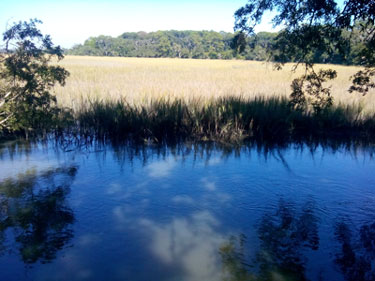 Once the retreat for the wealthy and upper crust of society, Jekyll Island today retains much of its history and charm from its heyday as an 19th century island resort. The historic district is home to nearly 300 acres of pristine and preserved natural areas and buildings. Once the retreat for the wealthy and upper crust of society, Jekyll Island today retains much of its history and charm from its heyday as an 19th century island resort. The historic district is home to nearly 300 acres of pristine and preserved natural areas and buildings.
Travelers to Jekyll can take a trip back in time and will delight in the sightseeing options that abound here in one of the largest restoration projects on the East Coast.
The English came when General Oglethorpe staked his claim and named the island in honor of his friend, Sir Joseph Jekyll. Oglethorpe, founder of Georgia, maintained an outpost on Jekyll Island, and a plantation was established by one of his officers, Maj. William Horton. He grew hops and barley and operated Georgia's first brewery supplying ale to the British regiment at nearby Frederica. Jekyll was the site of GA's first brewery and still standing are the century-year-old ruins of Horton's Brewery which, utilizing the mineral-rich island artesian well water, produced an uncommonly fine ale. |
|
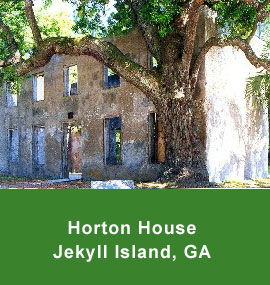 1792 -- a French aristocrat, Christopher Poulain duBignon, buys the island off the coast of Georgia known as Jekyll Island. Five generations of this family of French Royalists raised renowned sea island cotton. 1792 -- a French aristocrat, Christopher Poulain duBignon, buys the island off the coast of Georgia known as Jekyll Island. Five generations of this family of French Royalists raised renowned sea island cotton.
The rich keep close social ties as a way to keep themselves wealthy and in power. One of the social institutions of the wealthy was the New York Union Club. One of their members was Newton Finney a rising financier and railroad supplier. His wife was none other than Josephine duBignon of Jekyll Island.
Finney saw an opportunity to entice his colleagues to the island and make some money on Jekyll real estate. With his brother-in-law John Eugene Du Binion, Finney hatched a scheme to buy up all of Jekyll Island and sell it to his friends at a great profit.
1883 -- duBignon bought the island in its entirety for $8,000 dollars. The two collalborators promised the wealthy a paradise and the rich wanted an exclusive place where they could relax. Finney was able to persuade a number of robber barons to the island, including: J. P. Morgan, William Rockefeller, Marshall Field, Joseph Pulitzer and William Kissam Vanderbilt. They purchased memberships sight unseen (they had never been to the island). Finney originally planned for 50 memberships at $600 dollars each. |
|
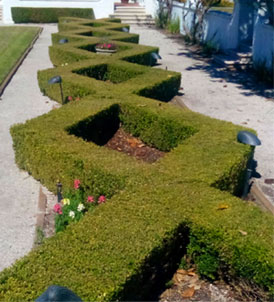 1886 (May) -- an investigative committee made an inspection tour of Jekyll Island. DuBignon made sure there were plenty of animals to see. 1886 (May) -- an investigative committee made an inspection tour of Jekyll Island. DuBignon made sure there were plenty of animals to see.
The committee must have been enchanted by the island, just one of the moss-draped, magnolia-dotted barrier islands. The barrier islands were accessible to yachts via the inland waterway. The weather allowed sailing, fishing, and golfing twelve months a year.
The committee laid plans for a club house that would provide visiting members housing and serve as the island’s social core. Landscape architect William Shaler Cleveland recommended that the club house not face the ocean but the renowned marshes of Glynn (made famous by a poem by Sydney Lanier.) Here there were fabulous sunsets that were very calming to view.
Architect Charles A. Alexander from Chicago was hired to draw up the plans for a Queen Anne style club house. He promised its completion by August 1, 1887, but he fell behind schedule. It was not finished until December 1, 1887.
It cost $45,000 dollars. The wealthy were wild about it. It was avant-garde. Their parents would not have liked it. It was not symmetrical, not balanced. It was serendipity all over, but it caught the younger generation’s little rebelliousness.
Alexander invited a journalist from neighboring Brunswick to visit the place. He wrote that the club house was an excellent structure unlike anything in this section. |
Jan 21, 1888 -- the Club House opened its doors to guests. It was a stunning success that lasted for the next forty years. It was a paradise for the affluent. The Club house had 60 rooms. There were three Club dining rooms -- one for servants, one for children, and one for adults only. Membership was now a cherished prize for the wealthy.
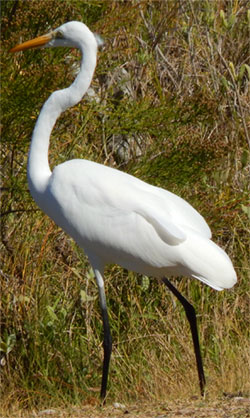 The members were met at the train in Brunswick by the club’s private launch, the Jekyll Island, under the command of James Agnew Clark. It ferried them across the wetlands to the island. The members were met at the train in Brunswick by the club’s private launch, the Jekyll Island, under the command of James Agnew Clark. It ferried them across the wetlands to the island.
Inside members found elegance and simplicity. The lobby was dominated by a large inviting fireplace with a hunting motif. There was room to sit and read and just relax. There were large picture windows. In addition, there was a large inviting dining room available.
But it was the outdoors that was the real enticement: hunting, fishing, swimming, bicycling, golf, tennis. There was also yachting. J P Morgan would anchor his yacht, the Corsair (his yacht, longer than a football field, was too large to tie up at the dock. Upon his arrival a cannon was shot to summon small craft to ferry him ashore). William Kissam Vanderbilt came with his yacht Alva and Joseph Pulitzer’s docked yacht Liberty. It became a contest to see which man came with the newest and sleekest yacht.
Other members of the financial elite who came to Jekyll Island were William Rockefeller, the Astors, Armours, Cranes, Goodyears, Macys, Biddles, and the Goulds. The Carnegies bought their own island. So did the Wanamakers, the R. J. Reynolds family, automobile tycoon Howard Coffin, and Beechnut LifeSaver tycoon Edward Noble.
Each member who had two shares was able to lease a plot of land to build a private residence. 15 "cottages" were built, some build by leading architects: Hastings and Carriers, David Adler, and John Russell Pope.
Members constructed private "cottages"-- enormous residences designed to house entire families with staff. The club was open for the post-Christmas season when many families came down from Newport and New York to relax and enjoy the "country life." |
|
1892 -- at age 71 inventor Gordon Mackay, the man who invented machines to sew shoe soles to the uppers, was one of the oldest members of the club when he build a spacious home with wide verandas overlooking the Jekyll River and the marshes of Glynn beyond.
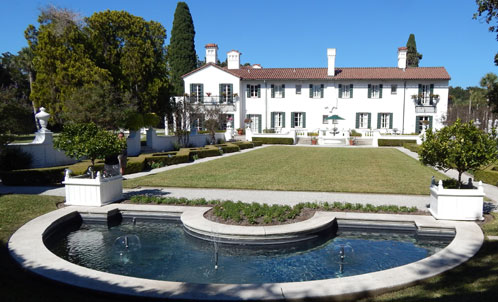 1896 -- the Moss Cottage built by William Strothers, the retired owner of a Philadelphia marble works. His favorite room was his den. He displayed some of the wildlife they killed on the island in the den. Window seats overlooked River Road. There was abundant wildlife outside. 1896 -- the Moss Cottage built by William Strothers, the retired owner of a Philadelphia marble works. His favorite room was his den. He displayed some of the wildlife they killed on the island in the den. Window seats overlooked River Road. There was abundant wildlife outside.
1898 -- Ernest Gilbert Grobe, a Swiss emigrant, was the club’s superintendent, a position he held for 42 years. He was a gracious host greeting the visitors at the docks. He was a benign dictator over the workers. He ran it as a large country house.
Social contacts were made around long leisurely dinners. It was a long lingering affair with many courses. It often consisted of the island’s bounty. Dinner in the evening was the highpoint with men rehearsing what they were going to say at dinner.
1900 December 26 -- William Strothers brought the first automobile to the island and it caused an uproar and he had to send it home by Mallory steamer. |
1903 -- Mackay died and his home was bought by William Rockefeller; he called it Indian Mound. (John D. Rockefeller refused to join Jekyll Island Club because he thought it far too expensive.)
1904 -- addition of the Faith Chapel. The Faith Chapel features replica wood carvings of the Cathedral of Notre Dame gargoyles and a stained-glass window created by Louis Comfort Tiffany (note his signature in the lower left corner) -- said to be one of five such in the nations.
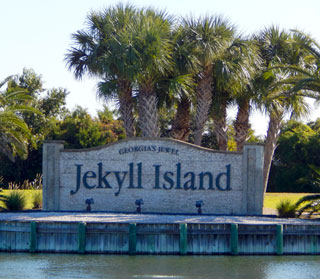 1910 -- In the early 1900s many in the nation felt there was a need for banking reform. Member James Stillman secretly approached Senator Nelson W. Aldrich about finding a solution and put the Jekyll Island club at his disposal. He organized a group of bankers to come to the island (dressed as duck hunters and came with aliases) to discuss the needed bank reforms. The so called no-name club arrived in November 11, 1910 in the off season. Surrounded by the Spartan elegance of the place, they worked day and night until they came up with a plan that would ease the crisis. No minutes were kept. They stayed at least two weeks, celebrating Thanksgiving here. 1910 -- In the early 1900s many in the nation felt there was a need for banking reform. Member James Stillman secretly approached Senator Nelson W. Aldrich about finding a solution and put the Jekyll Island club at his disposal. He organized a group of bankers to come to the island (dressed as duck hunters and came with aliases) to discuss the needed bank reforms. The so called no-name club arrived in November 11, 1910 in the off season. Surrounded by the Spartan elegance of the place, they worked day and night until they came up with a plan that would ease the crisis. No minutes were kept. They stayed at least two weeks, celebrating Thanksgiving here.
What they came up with was the Aldrich Plan that two years later would become the basis for the Federal Reserve System. Both Aldrich and a member of his committee Henry Palmroy Davison were so taken with the club that they both joined the club two years later.
1915 -- Member Theodore N. Vail, president of A T & T, placed the first transcontinental phone call from Jekyll Island with William Rockefeller, W. Wells Bosworth, S. B. Trowbridge, and J. P. Morgan Jr looking on. The call went to President Woodrow Wilson in Washington, Alexander Graham Bell in New York, and his assistant Thomas Watson in San Francisco. These members were the "techies" of their day. They wanted the latest toys.
William Lawrence, Episcopal bishop of Massachusetts, delivered some famous sermons. From his pulpit he preached his popular gospel of wealth. Riches were in league with godliness. No wonder he was so popular as a preacher. |
|
1920s --
The island prospered and two new additions were added to the Club House.
The Crane Cottage of Mediterranean architecture (the largest cottage on the island) dazzled many members. This "cottage" was the largest built on Jekyll. The oaken floor in the Crane cottage was actually a replacement for the original black and whit Italian marble, which the members' wives considered nouveau riche and suggested to Mrs. Crane that she eliminate, along with her too showy dinner parties for too many guests. Here also are Crane andirons, ingeniously designed to warm brandy bottles.
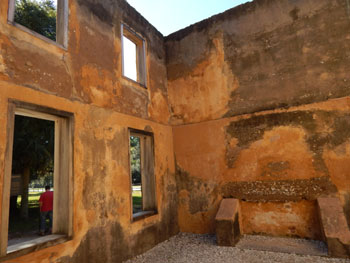 But a new resort was about to come on the scene. An inventor from Ohio, Howard Coffin, was a genius in automotive engineering. By 1925 his Hudson Motor Company was worth millions. He developed an interest in real estate. He found this area by sailing down the coast in 1911 with the governor of Georgia. He purchased an island near Jekyll for less than $150,000 dollars. He built a retreat, the Cloister. It was a public playground for the well-to-do. It was a place for Coffin to share a place with his friends. His young cousin Alfred W. Jones saw to the details of the building of the place. They had an almost father-son relationship but they also had a business relationship. But a new resort was about to come on the scene. An inventor from Ohio, Howard Coffin, was a genius in automotive engineering. By 1925 his Hudson Motor Company was worth millions. He developed an interest in real estate. He found this area by sailing down the coast in 1911 with the governor of Georgia. He purchased an island near Jekyll for less than $150,000 dollars. He built a retreat, the Cloister. It was a public playground for the well-to-do. It was a place for Coffin to share a place with his friends. His young cousin Alfred W. Jones saw to the details of the building of the place. They had an almost father-son relationship but they also had a business relationship.
They turned to one of the most famous architects of the day, Addison Meissner to build the retreat. In the early 1920s he had transformed Palm Beach, Florida. He weighed over 300 pounds. He had no training in architecture but had a natural feeling for the subject. He liked Spanish inspired designs. For the Cloister he designed a small elegant 46 room hotel.
Meissner was an eccentric design genius. He would sometimes forget to put in a closet or steps to the second floor.
Coffin and Jones enlisted landscape architect T. Miesy Baumgardner, nicknamed Bummy, to design the grounds. The place bloomed twelve months out of the year.
The Cloister cost $440,000 dollars. Coffin sold $50,000 dollars to local investors to give them a personal interest in his hotel. It was this move that a few years later helped save the Cloister from bankruptcy when the Depression hit. |
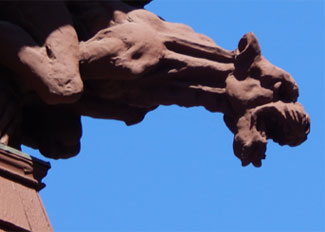 1928 -- official opening of his palace by the sea. The first guests were local investors in the Cloister. There was a grand Spanish lounge with high beam ceilings. Meissner designed oversized furniture for the lounge. It had to be cut down for people of more normal size. 1928 -- official opening of his palace by the sea. The first guests were local investors in the Cloister. There was a grand Spanish lounge with high beam ceilings. Meissner designed oversized furniture for the lounge. It had to be cut down for people of more normal size.
It was a real resort. They had a diving platform that was fifty feet high; dancing beneath the stars; organized activities for the children; and golfing on the links. Celebrities and notables gravitated to the Cloister.
1931 -- playwright Eugene O’Neill came seeking the peace that actress Eilka Chase assured him he would find there. He and his wife Carlotta built a home in the cottage community. It was here he penned his only comedy, "Ah, Wilderness."
President Calvin Coolidge christened the Cloister by planting a live oak tree, called the Constitution Oak, in the resort’s maiden year.
World War II sounded the death knell for one enchanted isle and new opportunities for the other.
There were rumors that German U-Boats were just off the coast of the Golden Isles. When in 1942 a cargo vessel was sunk nearby the mouth of the Brunswick River, all but two of the club members abandoned their private playground for good. All that remained was a skeleton maintenance crew and a National Guard unit to patrol the coast here.
Jekyll Island fell into disrepair and the Club House was left to weather away. |
|
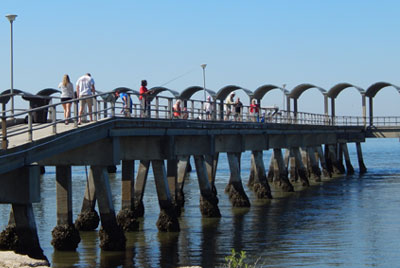 1947 -- the state of Georgia bought all of Jekyll and everything on it: the cottages, the clubhouse, the J.P. Morgan condominiums, the tennis courts, the golf course, and ten miles of beach -- for $675,000. The Cloister on Sea Island did better. 1947 -- the state of Georgia bought all of Jekyll and everything on it: the cottages, the clubhouse, the J.P. Morgan condominiums, the tennis courts, the golf course, and ten miles of beach -- for $675,000. The Cloister on Sea Island did better.
June 1949 - marriage of Sarah Churchill, daughter of Winston Churchill, to photographer Anthony Beaucamp.
President Jimmy Carter also planted a tree at the Cloister. President George Bush, honeymooning here in 1945, did likewise.
1986 -- the Jekyll Island Club House was not done-in completely. A group of enterprising investors bought the club house and area and set out to restore it to its former glory. The club house is open once more and not just to a privileged few. Legendary accommodations can be enjoyed here.
Jekyll became the site of Georgia's first brewery. Still standing are the century-year-old ruins of Horton's Brewery which, utilizing the mineral-rich island artesian well water, produced an uncommonly fine ale.
Here there is a 240-acre historic district along with the clubhouse, and the cottages. You may want to sign up for the conducted tours on the train trip through the historic district.
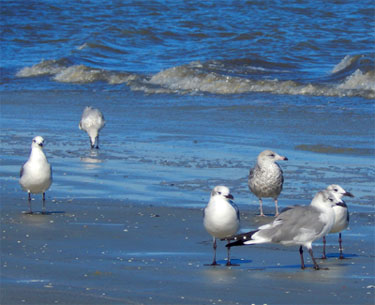 Today all kinds of vacationers can relax on the island where the elite once played. In August they hold an annual Beach Music Festival. Today all kinds of vacationers can relax on the island where the elite once played. In August they hold an annual Beach Music Festival.
(Lots of the information came from a television show on the program "World Tour" called "The Golden Isles: Jekyll Island Club House in the Age of the Robber Barons."
Jekyll Island Historic District is between Riverview Drive and Old Village Boulevard on Jekyll Island. The Club House is now a fully restored hotel open to the public. The island can be reached off of US 17 and Jekyll Island Road, southeast of Brunswick. Tour tickets are available on Stable Road at the museum orientation center. It is housed in the restored club stables. It contains exhibits and displays and a video about Jekyll Island.
Here there is a 240-acre historic district along with the clubhouse, and the cottages. You may want to sign up for the conducted tours on the train trip through the historic district.
Jekyll Island Historic District. Jekyll Island Historic District, a National Historic Landmark administered by the state of Georgia, is situated on the southeast side of Jekyll Island. kyll Island Clubhouse, now a hotel.
Most of the cottages have been preserved and are open to the public. Among them are San Souci, owned in part by J.P, Morgan and one of the first condominiums in the U.S.; Indian Mound, the twenty-five room home of the Rockefeller family; the Goodyear Cottage completed in 1906 from designs by the firm of Carrére and Hastings; Crane Cottage, circa 1917, the largest and most lavish of the cottages; the original Club House, a wood and brick Victorian structure with towers and manicured lawns; and Faith Chapel, built in 1904 in the Gothic style with copies of the Notre Dame de Paris gargoyles. The chapel also has a large signed Tiffany stained glass window. |
| Contact and Website |
| Phone: 912-635-4036 or toll free 877-453-5955- Jekyll Island Georgia Historic District Website |
|
|


Colonial Coast GA Travel Region Printable Map

GA Coast & Islands Fun:
 Festivals & Events Festivals & Events
 Free Outdoor Activities Free Outdoor Activities
 Tourist Centers Tourist Centers
 Travel Region Info Travel Region Info
|










